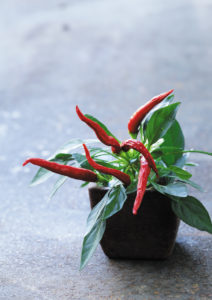Q. Could you explain the different between Determinate and Indeterminate tomatoes? Each year, I get so confused when I go to buy my tomato plants. In addition when is the ideal time to plant?
A. Tomatoes are classified by their growth habit and are called determinate and indeterminate varieties. Determinate varieties do better in smaller spaces making them ideal for containers such as an Earth Box, while the Indeterminate tomatoes are rigorous growers; hence they require staking and/or a tomato cage as they get quite large. Determinate plants are short, bushy and grow to only a height of about four feet. They are often called bush tomatoes. The tomatoes form on the terminals ends of the plants: hence, they are self topping and seldom require support. They stop growing when the fruit sets on the terminal or top bud ripen their entire crop, usually over a two week period, and then die. Indeterminate varieties continue to grow indefinitely until killed by a frost. I like to refer to them as the Energizer Bunny of tomatoes. The plant is always producing stems and leaves as the lead or terminal buds does not set fruit. The fruit set on the laterals instead. In addition, the fruit ripens progressively as the vine grows, so there are tomatoes in all stages of development at any one time. Cherry tomatoes varieties along with Early Girl, Brandywine and Big Boy are examples of Indeterminate tomatoes. Gardeners often make the mistake of planting tomatoes too early. The key in growing tomatoes and setting fruit is not the daytime temperatures. Tomatoes are a warm season crop that struggles and/or fails to set fruit with nighttime temperatures below 55 degrees. Once the plants are slowed down, they never recover and fail to meet expectations. Personally, I’d plant tomatoes between April 15 and May 15 after the rainy season has concluded.
Q. This year, I’d like to plant my peppers in containers. How many can I plant and can I mix both hot and sweet peppers together in the same pot?
A. Peppers grow very nicely in containers and yes, you can mix the hot and sweet varieties in the same pot. With chili or hot pepper varieties, you are better off waiting until the end of the month to plant or whenever the rainy season has concluded. The number of plants is determined by the size of the pot. I’d allow each plant about eight to twelve inches of space. If your pot is large enough, you could mix in Alyssum and Marigolds as companion plants to deter insect problems. Because of the nutrient depletion with every watering, I’d fertilize them with a vegetable food every other month or with Osmocote at the time of planting and again in July. Osmocote is a time release fertilizer that releases a little bit of nutrients with every watering. Peppers have shallow roots so you need to be careful when you cultivate and mulching is recommended to conserve moisture. Water conservation is enhanced by adding the plant polymer, Soil Moist, to the soil mix at planting. Soil Moist is a crystal that hydrates into a gel with water. The roots of plants use the gel as a back up réservoir extending the days between watering. All the pepper varieties are compatible with each other so there isn’t a problem with whatever varieties you choose.
Q. Is there a way to sterilize soil other than baking it in an oven? When I recycle the old soil from containers, I first sift the soil and then store it in trash cans. I find that the weed seeds are not killed when stored for a year or so.
A. Storing soil in a dark location isn’t an effective method of killing weed seeds. They can remain dormant for a long period and germinate when exposed to light and moisture. To effectively kill the weed seeds, soil insects and soil pathogens, the soil needs to be heated. For the home gardener, soil solarization is a simple non chemical technique that captures heat from the sun to sterilize soil. Commercial equipment is not cost effective while a household oven isn’t very practical. Soil sterilization is a sensible solution for large or small quantities of soil. You can tarp areas off an area or place small amounts of soil in plastic bags. It should be pre-moistened and then sealed or covered. The weeds seeds are killed as the temperature rises converting the moisture into steam. Depending on the quantity, it needs to bake in the sun for six to ten weeks. June through September is the primary period to sterilize soil using the sun. Once it’s been sterilized and aired out, you can store it in trash cans indefinitely. A back up plan is to control the weed seeds with pre-emergent herbicides. There are organic liquid as well as granular products available.
Leave a Reply